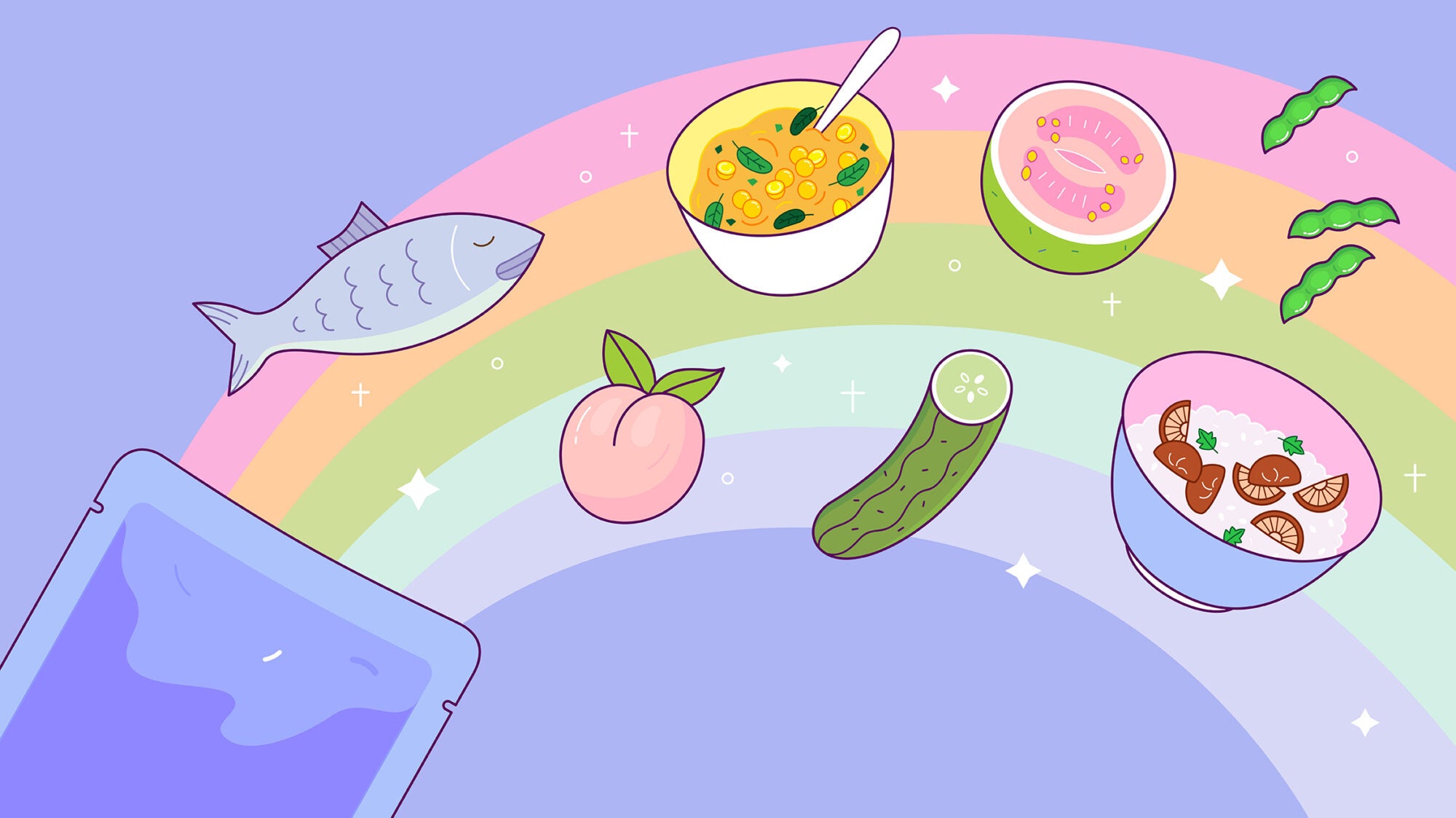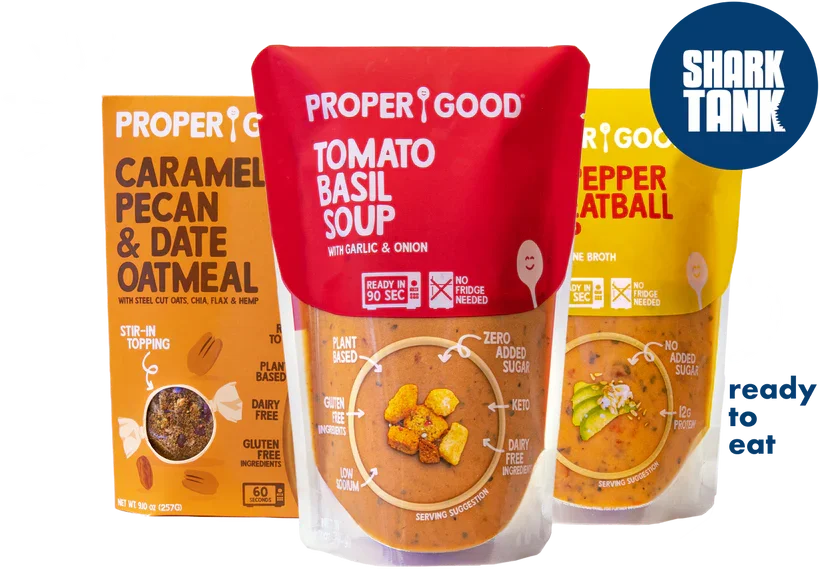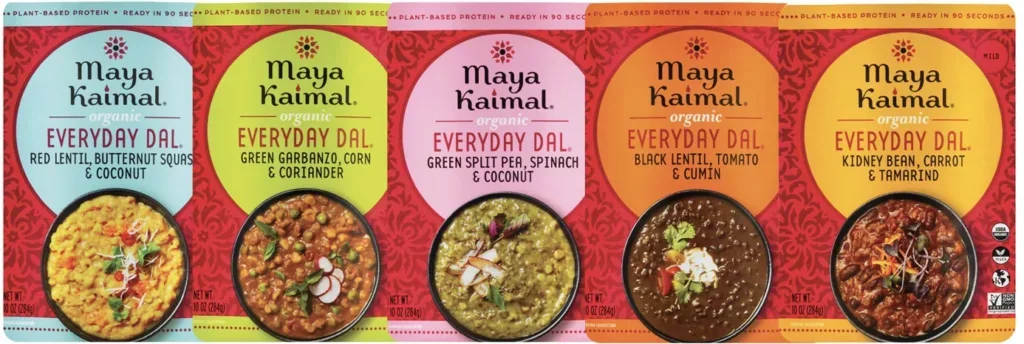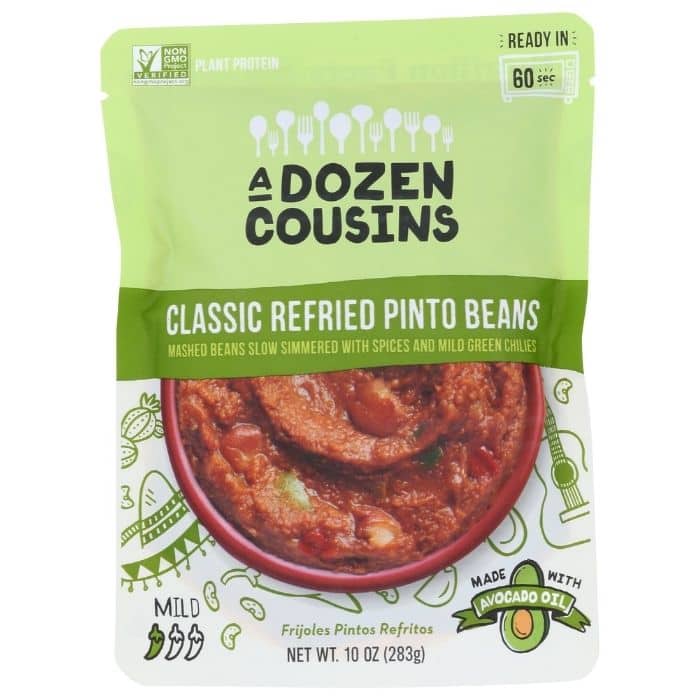
Not just for baby food anymore, delicious and convenient pouches are everywhere in the grocery store. What does that say about adults seeking a quick meal—and the environmental impact of our great shift to plastic?
Ibraheem Basir knew he had to do something about the state of his weeknight dinner routine. He was earning a six-figure salary working in marketing for an organic packaged foods company in Berkeley, California, but when he came home late at night, all he wanted to eat was takeout—and not salad bowls but the kind of foods he’d grown up with in Brooklyn, like fried chicken and biscuits or empanadas. This wasn’t a matter of price but convenience: he had the salary to buy more nutritious food, and he wanted to eat healthier, but none of the healthy and convenient options in the grocery store spoke to his cravings for comfort.
“You could cook from scratch, but the way we live has evolved a lot, and maybe we don’t always have the time,” says Basir.
The solution: a pouch.
In 2019, Basir launched his own brand of Latin, Caribbean, and Creole foods called A Dozen Cousins, with products like Trini chickpea curry with avocado oil and seasoned rice cooked in bone broth. When it came to choosing the packaging type, Basir says it was a no-brainer: 100% of the product line comes in single-portion-size, shelf-stable plastic pouches. From a supply chain perspective, they’re lighter to ship and get damaged less than cans, bottles, or boxes, he says. And for the consumer?
“It’s ready to eat in 60 seconds, and it doesn’t require tools, pots, or pans,” says Basir. Simply pop a pouch in the microwave and tear off the top.
Forget the tinned fish renaissance: increasingly, both independent start-ups and legacy brands are putting foods in pouches, creating a new wave of convenience food in portable, packable single servings. It started with baby food. Over the last couple decades, plastic pouches that allow toddlers to suck down food sans spoon have been largely replacing little jars in the baby food aisle. The pouches of 2024 check boxes in all categories—whether it’s full meals like chili or dal with rice, snacks like peanut butter and pickles, or even iconic canned foods like tuna, the pouchification of American grocery foods runs far and wide. And pouches may represent a sea change in adult eating habits: we’re all on the go, and we need our Go-Gurt, too.

Proper Good
If you’re old enough to remember—and have been infinitely frustrated by—Capri-Sun juice packs when they blew up in the early 1990s, you might recall that the packaging was a novelty. Poking a straw through the top without piercing the back of the pouch proved a challenge (pro tip: pop the straw in the bottom), but they helped introduce a generation of Americans to laminated pouches made from various layers of flexible plastic and metal foils. In industry speak, they’re known as doypacks, or stand-up pouches. Empty, they can be folded flat, making them economical to ship in bulk. Filled, they can stand upright on a grocery shelf thanks to, well, a pouch that bulges at the bottom. A similarly designed package where food is sealed and cooked inside the pouch itself is called a retort pouch. (This is the kind of pouch used today for many baby food purees, tunas, and curries.) These pouches were developed in the 1960s and ’70s; the first food product to be sold in one was a curry made by the Japanese brand Otsuka Foods Co. in 1968.
For beverages, pouches may not have offered consumers much more convenience than bottles or cans, but they were cheap and lightweight for the manufacturer; they were also handy for backpackers and astronauts, for whom light weight and packability is key. Yet while these pouches were becoming a more common packaging format for convenience foods sold around the world during the ’80s and ’90s, adoption beyond the shelves of REI was slow in the United States. Part of the reason may be that not everyone finds pouches aesthetically appealing.
Maya Kaimal was initially skeptical herself. As a cookbook author, she found that many Americans perceived Indian food as too complicated to make at home easily, so she launched her own popular, eponymous line of Indian sauces in 2003; initially they were found in the refrigerated aisle, until Kaimal began selling shelf-stable jars of simmer sauces in 2010. “I was all about ‘How can I make it seem as much like homemade cooking as possible?’” Kaimal recalls. “I thought that cooking sauce in a kettle and filling it in jars wasn’t a big leap from what you do at home—the whole pouch thing was just totally mystifying to me.”
Yet Kaimal saw that, among her few competitors, brands of sauces and ready-to-eat curries in pouches imported from India were finding their way onto American grocery store shelves. She was surprised that people seemed to be receptive to Indian food in that format, but she didn’t love the products she tasted. “I kind of dismissed the whole category for years. I thought you couldn’t make food taste good in a pouch,” she admits.
It’s difficult for a small company to invest in new packaging—manufacturers require huge minimum quantities, and you have to be confident that you can sell thousands of cases. But Kaimal was able to find a retort pouch manufacturer in the United States that was willing to test-trial some recipes with her, and she was ultimately pleased with the results.

Maya Kaimal
Her brand introduced individual serving-size pouches of dal and chana curries in 2018, and it was one of Kaimal’s most successful product launches to date. Like A Dozen Cousins’ offerings, they’re microwaveable, shelf-stable, and designed to bring anywhere for quick, single-serve meals. (In comparison, Kaimal’s jarred simmer sauces offer six servings and require you to add proteins or vegetables.) The company’s ready-to-eat pouched products have been among its fastest-growing items, and Kaimal has worked hard to keep up with demand. She says it’s consistent with her original mission for the brand: to make Indian foods that are authentic yet approachable to anyone for everyday eating. “The more convenient you can make it, the more apt [customers] are to try it—and that’s such a hurdle for Indian food,” Kaimal says.
While the resulting product may look completely different, processing food in a retort pouch is a lot like canning. Food is vacuum-sealed, and the pouches are heated under pressure, killing any microorganisms to prevent the contents from spoiling.
“A retort is essentially a big pressure cooker—it allows you to cook the food in pouches,” says Kevin McKay, chief operating officer of Safe Catch, a brand of canned tuna and other seafood that has been selling its flagship products in 3-ounce, serving-size retort pouches since 2016, in addition to its 5-ounce aluminum cans, the mainstay for tuna for the last century.
There are nuances to how it’s done, which can affect the taste and texture, says McKay. Safe Catch employs not only low-mercury fish and sustainable fishing practices but a “nothing added, nothing drained” approach when processing seafood for both cans and retort pouches. Many tuna manufacturers take the more efficient route of precooking the fish, then adding liquid back in the form of water or oil and sometimes an additive called pyrophosphate to help the fish absorb that liquid better. By cooking the tuna directly in the pouch or can, Safe Catch can cook it slowly, allowing it to retain its oils and flavors better, McKay says.
Retort pouches are slightly more expensive than aluminum cans, and the fish packed in them needs to be cut to a consistent thickness to promote even cooking. But the benefits of offering tuna in retort packages have greatly outweighed those challenges, McKay says. There will always be customers loyal to canned tuna, which is still by far its most popular format. Through the pouches, though, Safe Catch has been able to reach new customers who are looking for easy ways to get single servings of protein, ready to toss in a salad or a paleo bowl.
“People could throw a pouch in their backpack, travel on the go in the car. You can take it to your office in your bag,” says McKay.
The ring pull tab, so endeared in today’s tinned fish renaissance, doesn’t cut it for many people either. McKay says the company has received letters from senior citizens thanking them for the pouches because they’re much easier to open than the pull tabs on aluminum cans. Some families see the pouches as more kid-friendly, because there are no sharp edges like the ones you have after opening a can. McKay’s own children, aged four and five, will tear open pouches of tuna and eat them with their hands. “We’re still working on getting them to use forks more,” he admits.
The notion of cooking in plastic pouches—during the manufacturing process as well as by microwaving before eating—might sound like a bad idea, or even downright terrifying, due to numerous studies on the potential for plastic to leach chemicals into food, especially when heated.

A Dozen Cousins
But not all plastics are created equal, says Dr. Claire Sand, owner of Packaging Technology and Research. Only plastic that doesn’t leach out compounds can be used at the temperatures that are approved of by the FDA. The same is true for coatings inside food packaging made of metal, glass, or paper. However, Sand points out that testing science is advancing rapidly, and some containers (not just plastic) that were previously approved for use were later found to be dangerous—as with PFAS in paperboard food containers, which the FDA banned in February. The type of food and its chemical makeup (such as whether it’s an acidic or oily food) can also affect whether chemicals leach into it.
In the case of retort pouches with layers of materials that are bound by adhesives, there is the potential for high temperatures to result in additives leaching into the food. But the FDA regulates those temperatures. Sand says that the main danger around heating plastics occurs when consumers do it in a manner that hasn’t been approved by the FDA—like reheating leftovers in the microwave in takeout containers that were not intended for that purpose. “We have been using retort pouches in the US military since the 1970s. Prior to that time, soldiers had a high degree of rib injuries due to the cans cracking their ribs when soldiers landed on their packs,” says Sand.
Another cause for concern when it comes to plastic pouches over cans or glass? Their recyclability, or lack thereof. Aluminum and glass are infinitely recyclable without detriment to the quality of the recycled product. Plastic is notoriously difficult to recycle—if it even makes it there. By some estimates, only a paltry 5 to 6% of plastics are recycled in the United States. And when that plastic is sandwiched together with layers of other materials such as foil to make retort pouches, the process gets even more complicated. They’re technically recyclable—however, there are only a few outfits that can actually recycle them. One is a New Jersey–based start-up called TerraCycle, which offers a free recycling program for consumers to send in squeezable plastic pouches and their caps.
Despite the challenges of recycling, producers and retailers say that pouches have many environmental advantages over traditional packaging like cans and glass because they’re so much lighter and less resource-intensive to make. The flexible pouches are also less easily dented or damaged, resulting in less waste. “Flexible packaging has both a lower manufacturing cost and uses less energy in production than cans,” says April Lane, chief merchandising officer of the online grocer Thrive Market.
As an e-commerce retailer, the brand is always looking to reduce the weight of packages, to make shipping them less expensive. Founded in 2014, Thrive Market has been a big proponent of brands that sell food in pouches, like Proper Good. Thrive also launched its own line of cooked beans in pouches in 2018, and last fall, it added dals, chilis, and stews in single-serving pouches. Since pouches are collapsible and lightweight, you can fit more of them in a box (and in a truck) than cans or bottles. Lane points out that the benefits begin before the packaging is even filled with food: “This is a big energy and cost savings when you are shipping them to the manufacturer before they are filled,” says Lane.
Reducing carbon emissions through both manufacturing and shipping plastic pouches may be one environmental advantage over cans and glass. But how does that stack up with the endless recyclability of the latter materials? And what about the potential for plastics to end up in the ocean, where they’re broken down into microplastics that have been invading our waterways, our aquatic life, and our bodies in increasingly greater quantities?
“There is always this trade-off,” says Shelie Miller, a professor of sustainable systems at University of Michigan’s School for Environment and Sustainability. “I wish in my field it was easy to say, ‘all these materials are always better in all things,’ but in practice, there are always trade-offs where new innovations have some benefits and some disadvantages.”
Glass and aluminum are derived from mined products that require a tremendous amount of energy to produce. Because lightweight plastic packaging uses fewer materials and less supply chain energy, Miller says that it generally outperforms cans and glass from a climate impact perspective. A study that Miller authored found that, for instance, a 12-ounce glass bottle has roughly five times the climate impact of a 12-ounce plastic bottle. “Even with the lack of recycling infrastructure, the climate impacts of plastic are generally going to be lower,” she says.
Despite the challenges of recycling, producers and retailers say that pouches have many environmental advantages over traditional packaging like cans and glass.
Yet plastic has additional environmental impacts: when it ends up in waterways, plastics in particular become brittle and break down in various ways, allowing them to be mistaken for food by wildlife and become permanent pieces of tiny litter, or microplastics. Microplastics are now found in everything from human fetuses to brain tissue, and it’s estimated that the volume of microplastics in our environment may double by 2040.
“I personally wouldn’t feel overly comfortable using pouches strictly from a microplastic perspective,” wrote Kathryn Kellogg, a sustainable lifestyle speaker and blogger at Going Zero Waste, in an email. Kellogg says we need more efficient ways to recycle plastics, especially thin plastic films, which are so difficult to separate out for recycling and hence seldom are. “TerraCycle does a great job, but we need better and more convenient infrastructure for film in general.”
Miller notes that when plastics end up in a landfill, it’s an unfortunate wasted opportunity for resource reuse, but they do minimal harm there. So we also need to do a better job of ensuring that plastic does not escape into waterways, where it becomes microplastic.
“I think that packaging is a really important consideration, but it’s not the only sustainability consideration. It’s the thing inside the package that matters the most,” says Miller.
Consumers tend to focus on packaging because they take part in getting rid of it, and they choose which bin it goes in. But, says Miller, the most important contributor to greenhouse gases is the food and how it was produced. “We need to be thinking about the foods we buy and the environmental intensity of the food and making sure we’re reducing food waste,” she says.
To that extent, she says that the potential for food waste reduction is perhaps one of the greatest environmental draws of single-serving pouches. You have one portion and no leftovers to forget about and eventually waste.
This thought dovetails neatly with the intention of this new wave of adult foods in baby-food-like pouches: to feed a single person one meal, and nothing more, as conveniently as possible. Despite the romantic overtures among today’s food and lifestyle gurus on the value of eating together, as a family or with friends, this is how many Americans are getting their dinner in reality. And thanks to a new spate of independent brands producing single-serving pouch foods, you can say goodbye to Chef Boyardee and find some pretty delicious meals and cuisines from around the world in this format too. These include A Dozen Cousins, Maya Kaimal, and many more brands, like Brooklyn Delhi—whether it’s making Indian food feel more accessible on a weeknight or reaching customers hungry for healthy and culturally relevant foods without cooking or getting takeout, the pouch has been a go-to solution.
“Post-COVID, I think people are on the go even more now, so the convenience factor and the time-saving factor is huge,” says Lane of Thrive Market.
With sales of pouched products exceeding the expectations of many producers, it’s fair to assume we’ll be seeing more of them in grocery stores in the years to come. Who knows? The next generation of adults, raised largely on pouches, might even find them nostalgic.